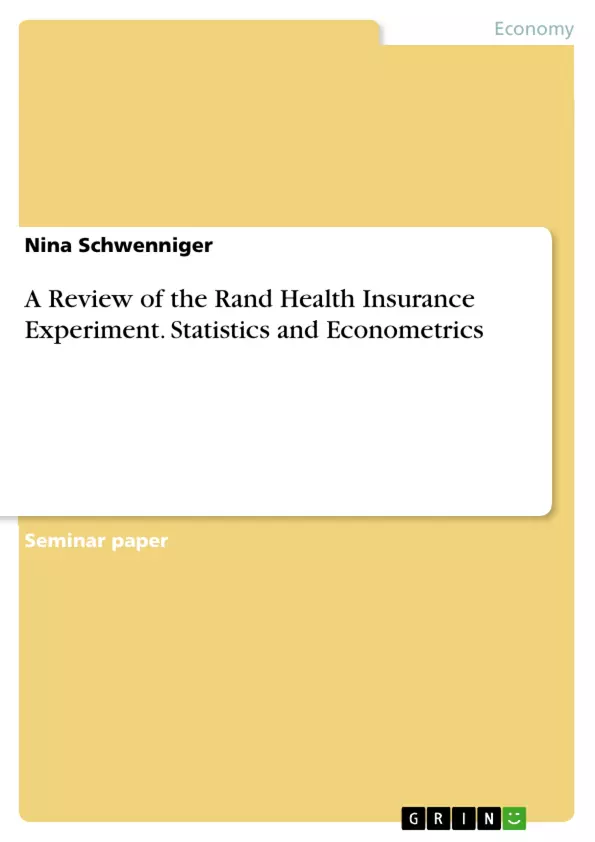The famous RAND Health Insurance Experiment (RAND HIE) deals with the question how health insurance affects medical spending. The scientific essay The RAND Health Insurance Experiment, Three Decades Later (2013) by Aviva Aron-Dine, Liran Einav, and Amy Finkelstein, extracted from the Journal of Economic Perspective, forms the basis for this seminar paper. All facts regarding the primary experiment are taken from this essay.
It features a reexamination of the core findings of the RAND HIE with a state of the art perspective regarding the analysis of randomized experiments and the economics of moral hazard. Between 1974 and 1981, more than 5,800 individuals from about 2,000 households in six different locations across the United States participated in the RAND HIE and thereby received health insurance. The experiment randomly assigned families to health insurance plans with different levels of cost sharing and was representative of families with adults under the age of 62. The plans ranged from full coverage (“free care”) to plans with little coverage (5 percent) for the first approximately $4,000 (in 2011 dollars) incurred during a year.
The conduct and analysis of randomized experiments as well as the economic analysis of moral hazard in the context of health insurance were relatively novel fields of research back in the years of the RAND investigation. Nevertheless, the RAND results are highly esteemed when predicting the likely impact of health insurance reforms on medical spending or design-ing actual insurance policies. In the course of time, health spending has grown and the consequent pressure on the public sector confers additional significance to the RAND estimates.
The RAND HIE was funded by the US Department of Health, Education, and Welfare and cost roughly $295 million (in 2011 dollars). From a cost perspective alone, a replication of such an experiment is highly improbable.
In section two, the design of the RAND HIE is presented and complemented by a depiction of the key economic object of interest, namely the impact of health insurance on medical spending. Section three describes the experimental analysis, including the baseline regression. The core variable of interest, the treatment effect, is specified and validated. In section four, the price elasticity is derived and the application discussed. Section five emphasizes the raison d’être for a randomized experiment based on statistical evidence and additional literature.
Table of Contents
- Introduction.
- The RAND Health Insurance Experiment
- Experimental Analysis
- Treatment Effects.
- Validation and Robustness.
- Price Elasticity
- Empirical Background.…….....
- Application and Problematic Nature ....
- Raison d'être of an Experiment
- Endogeneity Problem.
- Potential Outcome Model.
- Methodology.
- Conclusion...
Objectives and Key Themes
This seminar paper examines the RAND Health Insurance Experiment (RAND HIE) and its impact on medical spending. It focuses on the findings of the study, the analysis of randomized experiments, and the economic concept of moral hazard.
- The impact of health insurance on medical spending.
- The design and implementation of the RAND HIE.
- The analysis of randomized experiments in health economics.
- The economic concept of moral hazard in the context of health insurance.
- The price elasticity of healthcare utilization.
Chapter Summaries
- Introduction: This chapter provides an overview of the RAND HIE, its objectives, and its significance in the context of health economics. It introduces the study by Aron-Dine et al. (2013) and its re-examination of the RAND HIE findings.
- The RAND Health Insurance Experiment: This chapter details the design of the RAND HIE, including the assignment of families to different health insurance plans with varying levels of cost sharing. It describes the experiment's duration, the types of plans offered, and the use of a "finite selection model" for sample assignment.
- Experimental Analysis: This chapter discusses the experimental analysis of the RAND HIE, including the baseline regression. It focuses on the treatment effect, its specification, and its validation.
- Price Elasticity: This chapter derives the price elasticity of healthcare utilization and explores its application. It examines the empirical background and the problematic nature of the price elasticity calculation.
- Raison d'être of an Experiment: This chapter discusses the rationale for using a randomized experiment in the context of the RAND HIE. It explores the endogeneity problem, the potential outcome model, and the methodology employed.
Keywords
Key terms and concepts explored in this seminar paper include: RAND Health Insurance Experiment, health insurance, medical spending, randomized experiments, moral hazard, price elasticity, treatment effect, endogeneity problem, potential outcome model, and healthcare utilization.
- Citar trabajo
- Nina Schwenniger (Autor), 2015, A Review of the Rand Health Insurance Experiment. Statistics and Econometrics, Múnich, GRIN Verlag, https://www.grin.com/document/300637



